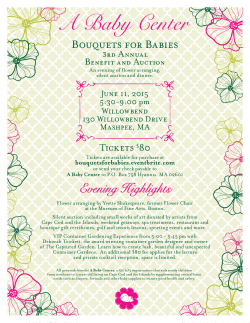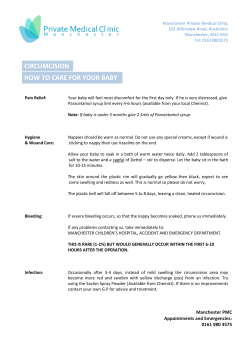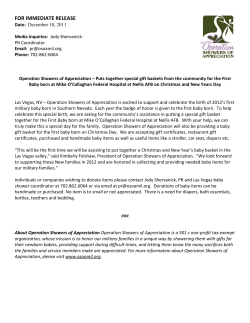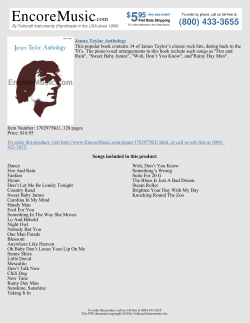
introduction to functional learning
An Introduction to The Waldon Approach Functional Learning Picking up and Placing Young children learn by doing things. But what happens when they don't just get on with it, when they don't move about and explore very much? The Waldon Approach/Functional Learning addresses the problems of these children. It's all about helping children to develop their Learning to Learn Tools. It's also a family approach, supporting the everyday life of all the family. Parents feel empowered and realise they can make a difference in their children’s lives. They begin to look at play and learning with different eyes. They see that the intensive work done in the Functional Learning Lessons supports their child’s learning in other settings, at home, in the garden, at the park, at the shops. All that focused unscrewing and screwing of glass jar lids suddenly translates to their little one being able to open doors at home -‐ independently. 1 ‘Every Child Can Learn’ Having a child with delayed learning can be very hard for families. Children with learning problems usually also have language and communication issues, they often have eating problems, and some of their behaviour can be very challenging. Every Child Can Learn by Katrin Stroh, Thelma Robinson and Alan Proctor (Sage 2008) describes a therapeutic programme that addresses all these issues. The central focus is the Waldon/Functional Learning approach based on the development of learning tools. Illustrated by Jane Dickson, the book is a handbook for parents, teachers and other professional facilitators, bringing together all aspects of the everyday life of children who can’t just get on with their early learning and whose families needs all the support they can get to help activate this vital process. ‘Autism and Understanding’ The philosophy behind The Waldon Approach together with explanations of the methodology both by the author and other teachers is set out in Autism and Understanding by Walter Solomon, with Mary Jo Middleton and Chris Holland (Sage 2012). The book which includes the well documented recovery of the author’s son, was described by the reviewer from the Autistic Society as: ‘a book I am going to treasure’ and includes about thirty case studies of children who also benefited from the application of Geoffrey Waldon’s ideas. It is a book written for parents and teachers of all developmentally delayed children. 2 THE WALDON APPROACH/FUNCTIONAL LEARNING. The Waldon Approach/Functional Learning is based on the play of the normally developing child. It is an approach developed by Dr George Stroh and his staff at High Wick Hospital School in the 1970’s based on the teaching techniques, and underpinned by the early learning philosophy, of Dr Geoffrey Waldon. All the authors of Every Child Can Learn and Autism and Understanding were colleagues of Waldon. Dr Waldon, an extraordinarily gifted thinker, neurologist and educator based in Manchester, devised a whole theory to explain the early learning of children. He used the phrase Learning to Learn Tools to describe the mental or cognitive tools which children develop over the first 3 or so years of their lives as they sample their physical environment through complex movements and sensory exploration. Functional Learning and the Waldon Approach share common theory and practice. In addition, Functional Learning is an integrated approach, which includes supporting feelings, understanding and communication of the whole family. PLAY Play normally means lots of spontaneous free exploration, curiosity, problem solving, effortful movement, endless repetition of tasks, but always with tiny changes of movement, which informs more practice and more learning. There is also pleasure in just doing the activities. When babies are learning about their physical environment as they play, they are doing this for themselves. Parents and other family members may be close by but the baby will normally get on with this kind of play regardless of any social reinforcement. Of course social interaction is also vital for early learning. But the sort of early learning we describe here is the non-‐social sort: it goes on despite what is happening around the baby. This early play and learning is the foundation for the Learning to Learn Tools. 3 LEARNING TO LEARN TOOLS Early Learning to Learn Tools cover five main areas of learning: [1] Pairing which leads to Matching, [2] Separating which leads to Sorting, [3] Sequencing which leads to Seriation, [4] Piling which leads to Brick Building and [5] Banging which leads to Use of Tools. Before these Tools can be established over the first three or so years of life, the baby has to do a lot of Placing. To start with, placing for the baby usually involves mouthing. Later, objects are held and explored in the baby’s hands and then placed deliberately somewhere else. Although when we talk about the Learning Tools we refer to specific areas of learning, as the Tools develop in the young child they often overlap and they emerge in a non-‐linear fashion. Early Pairing can be illustrated by a baby picking up a cup and then looking around and finding another cup the same, or a child putting his foot into his father’s shoe. Matching describes the child’s ability to keep the model of something in his mind whilst actively searching for something relating to this model. Scanning to find a contact on your mobile phone is an example of Matching. THE TREASURE BASKET The Treasure Basket, which was originally developed by Eleanor Goldschmied in the 1980’s, is perfect for focused non-‐social play before the child explores the world as a toddler. These are baskets made up for babies so that they can play as they learn to sit up. They contain a huge variety of interesting objects made from natural materials. There are metal things, wooden things, hard, soft, smelly, large, small, heavy, light objects etc. Placing If you place a baby of around 4 months of age in front of a Treasure Basket, over the next few months you will see some extraordinary learning taking place, specifically related to the earliest development of the Learning to Learn Tools. To begin with the baby will pick an object up and put it in their mouth. As the baby sees another object and goes for this with their other hand they will drop the first object. The continuous mouthing of the normal baby, the picking up and letting go gradually extends to reaching out and placing objects away from the body and later, into containers. 4 Banging As babies learn to hold two objects at once in an early Pairing action, they will often bang them together. This effortful and pleasurable activity leads to grasping and holding a variety of objects, which can be hit rhythmically, dropped or thrown and which make great sounds. Hitting a saucepan with a metal spoon, scraping a surface with a wax crayon, turning a pot over using a hairbrush are all ways of practicing and learning about Use of Tools. Writing and the ability to use tools in order to solve problems develop out of these activities Pairing The baby eventually begins to hold a chosen object from the Treasure Basket for longer periods but will still drop this object when his gaze returns to the basket, and the baby then attempts to picks up something else which interests him. Soon the baby can hold two of the same objects in his hands at the same time. This is the beginning of Pairing. Pairing 5 Separating In another Treasure Basket play session the baby might notice that all the spoons have shapes, which are particularly good to suck. The baby explores the different metal and wooden spoons, the different shapes, the lengths of handle etc. She might find and begin to search for the spoons in the basket. Pairing involves two objects that are the same. As soon as a baby picks up and does something with three or more similar objects this is the beginning of learning about groups, which in the the Waldon Approach/Functional Learning sense is Separating. This leads to Sorting and then the mature mental tool of classification. Early Sequencing Banging rhythmically, placing systematically and following a pattern of movement indicates early Sequencing. Although the photo below is not of a Treasure Basket, the treasures of the beach give the boys a fantastic opportunity to practice their early Sequencing! Sequencing stones at the beach 6 Piling Then we suddenly notice that the baby who is now 8 months and is still interested in using the Treasure Basket has been learning to pile the objects on top of each other, accidentally at first when the objects dropped, but now more deliberately. All this time the baby has been practicing moving the whole body, the arms and the hands in a huge variety of different ways. Because movements have become more controlled, the baby can actually place the metal spoon on top of the woolly gloves and then the toothbrush on top of this, followed by the biscuit. This is Piling which leads to Brick Building. Away from the seated position at the Treasure Basket young children find another treasure trove with wooden bricks. Wooden bricks have weight and density. They have grain and smell. They can be of different sizes and shapes. Making a pile of similar bricks stand on top of each other involves very careful Placing, Pairing, Separating, Sequencing and of course Brick Building. There will also be the joyful Banging experience as the bricks are placed and accidentally fall down or get pushed down. All of the early learning comes together! 7 THE WALDON APPROACH/FUNCTIONAL LEARNING LESSON This is a special time of focused work for a child with learning delay. The Lesson is not teaching the child what to do in the conventional sense. It is a contained and structured environment that supports the early general learning. It provides opportunity for experiences and a variety of movements, which so often children with delay have not been able to access or even learn to avoid. All the activities are based around the acquisition of the Learning to Learn Tools and in the early stages are focused on Placing and Banging. The lesson can last up to one hour, three to four times a week, with the parents working at home with the child. The parents also take their child to a Functional Learning teacher once a week when possible. The child sits at a table with a chair that is the correct size for them; the teacher sits behind or at the side and uses no language. This is what we call the non-‐social setting, one of the defining features of early play when normally developing babies explore the physical environment for themselves. When the teacher wants to indicate how to do an activity the hands of the child are guided so that the teacher’s hands are like an extension of the child’s hands. Guiding a child’s hands (from Every Child Can Learn) 8 Although all the activities in a Waldon Approach/Functional Learning Lesson are pitched within the understanding of the child, very often children with learning delay find new situations distressing particularly when they involve moving outside their physical comfort zone. Sometimes the child has not learned to sit at a table or may be unused to stretching to pick something up. There may be reactions to these new experiences, including screaming, or throwing or not letting go of the object. But over time, the child begins to learn that the activities are non-‐threatening and can even become pleasurable. The teacher always works with the child but without talking or praising the child. Both teacher and child are focused on the activity. It is the doing, at this stage, which is so important, exactly like the play of the normally developing child. Every Child Can Learn clearly describes activities and resources relating to the Functional Learning Lessons. 9 WORK AT HOME Wherever possible both parents are encouraged to work at home and give their child lessons based on the work done with a trained Waldon Approach/Functional Learning teacher. When the parents work with their child in a supervised lesson, the teacher shows them new activities and resources, and approaches for the family to work on at home, before the next visit. Parents are also encouraged to see the teacher without their child so any concerns can be aired more easily. The Functional Learning approach involves supporting the whole family. Feelings can be heightened at particular times of the day like meal times and bedtimes, and these times can become very stressful for everyone. Every Child Can Learn suggests ways of dealing with the stresses and strains of everyday life, and how to help the different members of the family. Everyone is important. Very often when new ideas are being introduced into the family setting, like eliminating loud background music when eating a meal, or encouraging more cooking which helps to alleviate eating problems, or using fewer words when communicating, ALL the family need to be involved. Working on domestic jobs like setting the table or cooking, or personal jobs like dressing and washing hands, is a great way of practicing the early Learning to Learn Tools. Dressing involves Placing clothes, choosing the correct object to Pair with the body part (e.g. sock on foot), Separating the clothes (e.g. the jumper with long arms is different from the trousers with long legs), Sequencing (e.g. the underpants are placed before the trousers) and of course working out how to do laces or use Velcro involve Use of Tools. But children with delayed learning often find these personal jobs very challenging. Confrontations and patterns of avoidance are played out on a daily basis. But patterns can be changed by practicing general principles in the Lessons, for example lots of Placing of different socks on dolls, Separating items of clothing etc. This breaks the job down into constituent parts and makes the process, when practiced at home in smaller segments, more meaningful, and over time, less threatening 10 GENERALISATION The Waldon Approach/Functional Learning lessons focus on activities which help children develop the Learning to Learn Tools. But the activities, which can be great fun in themselves with endlessly interesting resources, must also provide opportunities for learning. The activities are not the end result. As practitioners we must always ask ourselves: Is the child exploring different movements, and learning to control movements? Is the child building up concentration and focus, learning to make decisions and change their mind? Is the child learning to choose, sit for longer, move around the room and keep their job in mind for longer? Is the child learning to overcome small and then bigger challenges? Of course we develop new activities as the child approaches the work in a more mature fashion so that the early object work moves to work with cards, and pencil and paper. But the structure of the lesson is informed by the child’s own learning and needs to be infinitely flexible. Very often parents will notice changes in their child at home, which they can relate back to work in the lessons. One child had been practicing lots of different ways of using two hands together, carrying a tray of balls, or Brick Building. The parents reported a few weeks later that their child used both hands to push a large towel into the washing machine for the first time. After picking up and Placing hundreds of bricks with alternate hands in lessons with their child, another parent noticed that their child used alternate hands when putting toys away in the tidy box. Another parent noticed that after weeks of unscrewing and screwing jar lids for the Placing activities, their child, who had become interested in the knob on the kitchen door, had worked out how to open the door. These may be small steps along the way towards independent learning, but they require lots of time and effort, they are meaningful and above all, pleasurable. 11 More Reading: Every Child Can Learn by Katrin Stroh, Thelma Robinson and Alan Proctor (Sage 2008) is a handbook of Functional Learning, for families and practitioners. It provides all the ingredients to allow parents to develop a comprehensive programme for their child at home. Autism and Understanding by Walter Solomon with Mary Jo Middleton and Chris Holland (Sage 2012) is an account of how his son was helped by Dr Waldon. It includes two chapters on the Waldon philosophy and practice. There are also accounts by teachers who use the approach, other parents whose children were helped by Dr Waldon, as well as several young people reflecting on their experience. The Waldon Association website (www.waldonassociation.org.uk) describes The Waldon Approach, and makes available on line much of Waldon’s unpublished writing. The Association continues to run training workshops in Leeds. www.autismandunderstanding.com contains clips of Geoffrey Waldon working and provides comprehensive training for parents and practitioners backed up by Skype supervision. www.janeblattatwork.com describes work by a Functional Learning practitioner and has a continuing Blog on the subject of child development Developing Play for the Under 3’s: The Treasure Basket and Heuristic Play by Anita Hughes (Routledge 2010) describes the creative and exploratory play of babies and toddlers. It is also an excellent introduction to how to create and use a Treasure Basket. This booklet is intended as an accompaniment to Every Child Can Learn, originally published by SAGE Publications and ©Katrin Stroh, Thelma Robinson and Alan Proctor, 2008. The material in this booklet may not be reproduced for use by others without prior written permission from the authors. All material is ©Jane Blatt, 2015. 12
© Copyright 2025









